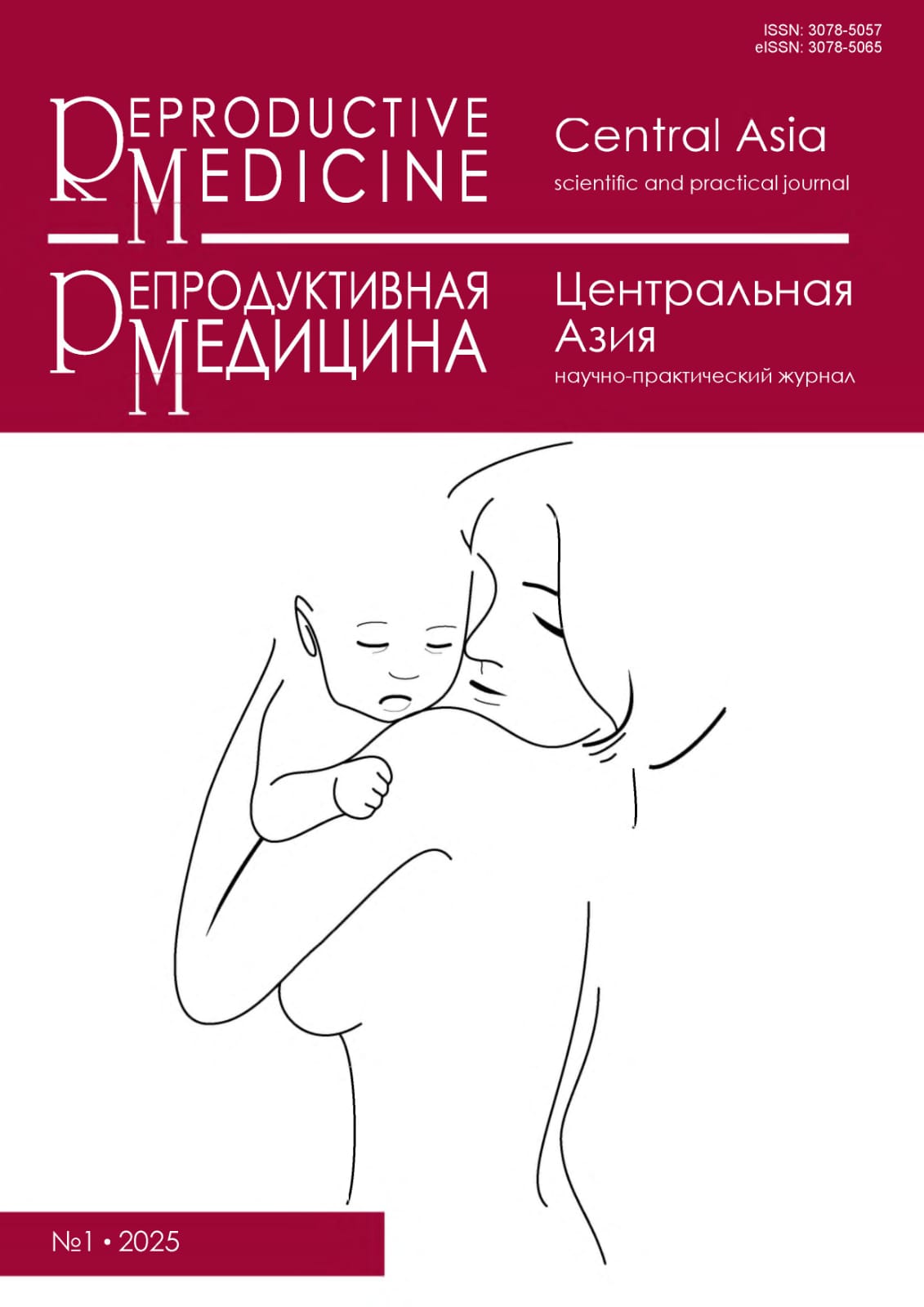Прогностические биомаркеры эклампсии: мета-анализ
DOI:
https://doi.org/10.37800/RM.1.2025.430Ключевые слова:
эклампсия, преэклампсия, беременность, биомаркер, прогнозированиеАннотация
Актуальность: эклампсия представляет собой жизнеугрожающее осложнение беременности, сопровождающееся судорогами и потерей сознания, на фоне преэклампсии. ВОЗ оценивает, что 10–15% материнской смертности связано с гипертензивными расстройствами, включая эклампсию.
Цель исследования: провести всесторонний анализ ключевых биомаркеров для прогнозирования эклампсии, опираясь на данные из высококачественных исследований за последние 10 лет.
Материалы и методы: включено 40 исследований из баз данных PubMed, Scopus и Cochrane Library, охватывающих биомаркеры sFlt-1/PlGF, внеклеточную ДНК (вкДНК) и генетические маркеры воспаления. Проводился анализ данных методом PRISMA, с расчетом отношения шансов (ОР) и 95% доверительных интервалов (ДИ).
Результаты: соотношение sFlt-1/PlGF оказалось наиболее точным предиктором эклампсии (ОР = 7,5; 95% ДИ: 5,6–9,9; p<0,001). Уровни вкДНК (ОР = 6,3; 95% ДИ: 4,7–8,4; p<0,001) и полиморфизмы генов IL-10 и TNF-α (ОР = 3,9; 95% ДИ: 2,8–5,4; p < 0,001) также показали значимость.
Заключение: комбинированное использование биомаркеров sFlt-1/PlGF, вкДНК и генетических тестов повышает точность прогнозирования эклампсии, что имеет значительные клинические перспективы.
Библиографические ссылки
World Health Organization. Maternal mortality. WHO; 2024.
https://www.who.int/news-room/fact-sheets/detail/maternal-mortality
Say L, Chou D, Gemmill A, Tuncalp O, Moller AB, Daniels JD, Glmezoglu AM. Temmerman M, Alkema L. Global causes of maternal death: a WHO systematic analysis. Lancet Glob Health. 2014;2(6):e323-e333.
https://www.thelancet.com/journals/langlo/article/PIIS2214-109X(14)70227-X/fulltext
Chen A, Tian M, Luo Z, Cao X, Gu Y. Analysis of the evolution of placental oxidative stress research from a bibliometric perspective. Front Pharmacol. 2024;15:1475244.
https://doi.org/10.3389/fphar.2024.1475244
Poon LC, Shennan A, Hyett JA, Kapur A, Hadar E, Divakar H, McAuliffe F, da Silva Costa F, von Dadelszen P, McIntyre HD, Kihara AB, Di Renzo GC, Romero R, D'Alton M, Berghella V, Nicolaides KH, Hod M. The International Federation of Gynecology and Obstetrics (FIGO) initiative on preeclampsia: A pragmatic guide for first-trimester screening and prevention. Int J Gynaecol Obstet. 2019;145 Suppl 1:1-33.
https://doi.org/10.1002/ijgo.12802
Lecarpentier É, Vieillefosse S, Haddad B, Fournier T, Leguy MC, Guibourdenche J, Tsatsaris V. Placental growth factor (PlGF) and sFlt-1 during pregnancy: physiology, assay and interest in preeclampsia. Ann Biol Clin (Paris). 2016;74(3):259-267.
https://doi.org/10.1684/abc.2016.1158
Fadigas C, Peeva G, Mendez O, Poon LC, Nicolaides KH. Prediction of small-for-gestational-age neonates: screening by placental growth factor and soluble fms-like tyrosine kinase-1 at 35-37 weeks. Ultrasound Obstet Gynecol. 2015;46(2):191-197.
https://doi.org/10.1002/uog.14862
Stepan H, Hund M, Andraczek T. Combining biomarkers to predict preeclampsia. Pregnancy Hypertens. 2020;20:92-98.
https://pmc.ncbi.nlm.nih.gov/articles/PMC7098437/
Lai J, Syngelaki A, Nicolaides KH, von Dadelszen P, Magee LA. Impact of new definitions of preeclampsia at term on identification of adverse maternal and perinatal outcomes. Am J Obstet Gynecol. 2021;224(5):518.e1-518.e11.
https://linkinghub.elsevier.com/retrieve/pii/S0002-9378(20)31286-2
Chaemsaithong P, Gil MM, Chaiyasit N, Cuenca-Gomez D, Plasencia W, Rolle V, Poon LC. Accuracy of placental growth factor alone or in combination with soluble fms-like tyrosine kinase-1 or maternal factors in detecting preeclampsia in asymptomatic women in the second and third trimesters: a systematic review and meta-analysis. Am J Obstet Gynecol. 2023;229(3):222-247.
https://www.ajog.org/article/S0002-9378(23)00196-5/abstract
Da Silva MLS, Gomes SEB, Martins LZ, Rodrigues SD, Toghi CJ, Dias-Junior CA. Impaired Endothelium-Dependent Vasodilation and Increased Levels of Soluble Fms-like Tyrosine Kinase-1 Induced by Reduced Uterine Perfusion Pressure in Pregnant Rats: Evidence of Protective Effects with Sodium Nitrite Treatment in Preeclampsia. Int J Mol Sci. 2024;25(20):11051.
https://doi.org/10.3390/ijms252011051
Palei AC. Cell-free DNA as a potential biomarker for preeclampsia. Expert Rev Mol Diagn. 2021;21(12):1253-1256.
https://doi.org/10.1080/14737159.2021.1997593
Ma Y, Ma M, Ye S, Liu Y, Zhao X, Wang Y. Association of IL-17 and IL-27 polymorphisms with susceptibility to recurrent pregnancy loss and preeclampsia: A systematic review and meta-analysis. Immun Inflamm Dis. 2023;11(10):e1057.
https://doi.org/10.1002/iid3.1057
Kenny LC, Black MA, Poston L, Taylor R, Myers JE, Baker PN, McCowan LM, Simpson NA, Dekker GA, Roberts CT, Rodems K, Noland B, Raymundo M, Walker JJ, North RA. Early pregnancy prediction of preeclampsia in nulliparous women, combining clinical risk and biomarkers: the Screening for Pregnancy Endpoints (SCOPE) international cohort study. Hypertension. 2014;64(3):644-652.
https://doi.org/10.1161/HYPERTENSIONAHA.114.03578
Park HJ, Shim SS, Cha DH. Combined screening for early detection of preeclampsia. Int J Mol Sci. 2015;16(8):17952-17974.
https://doi.org/10.3390/ijms160817952
Ng KW, Chaturvedi N, Coté GL, Fisher SA, Mabbott S. Biomarkers and point of care screening approaches for the management of preeclampsia. Commun Med (London). 2024;4(1):208.
https://doi.org/10.1038/s43856-024-00642-4
Duhig KE, Myers J, Seed PT, Sparkes J, Lowe J, Hunter RM, Shennan AH, Chappell LC; PARROT trial group. Placental growth factor testing to assess women with suspected preeclampsia: a multicentre, pragmatic, stepped-wedge cluster-randomised controlled trial. Lancet. 2019;393(10183):1807-1818.
https://doi.org/10.1016/S0140-6736(18)33212-4
Barrientos G, Pussetto M, Rose M, Staff AC, Blois SM, Toblli JE. Defective trophoblast invasion underlies fetal growth restriction and preeclampsia-like symptoms in the stroke-prone spontaneously hypertensive rat. Mol Hum Reprod. 2017;23(7):509-519.
https://doi.org/10.1093/molehr/gax024
Greenberg VR, Silasi M, Lundsberg LS, Culhane JF, Reddy UM, Partridge C, Lipkind HS. Perinatal outcomes in women with elevated blood pressure and stage 1 hypertension. Am J Obstet Gynecol. 2021;224(5):521.e1-521.e11.
https://linkinghub.elsevier.com/retrieve/pii/S0002-9378(20)31279-5
Bartsch E, Medcalf KE, Park AL, Ray JG. High risk of preeclampsia identification: a systematic review and meta-analysis.
Int J Obstet Gynaecol. 2016;123(9):1441-1454.
https://doi.org/10.1136/bmj.i1753
Satorres-Pérez E, Martínez-Varea A, Novillo-Del Álamo B, Morales-Roselló J, Diago-Almela V. The sFlt-1/PlGF Ratio at 12, 24, and 32 Weeks Gestation in Twin Pregnancies as a Predictor of Late Preterm Birth and Perinatal Event Secondary to Prematurity.
J Clin Med. 2024;13(9):2699.
https://doi.org/10.3390/jcm13092699
Magee LA, Wright D, Syngelaki A, von Dadelszen P, Akolekar R, Wright A, Nicolaides KH. Preeclampsia Prevention by Timed Birth at Term. Hypertension. 2023;80(5):969-978.
https://doi.org/10.1161/HYPERTENSIONAHA.122.20565
Brown MA, Magee LA, Kenny LC, Karumanchi SA, McCarthy FP, Saito S, Hall DR, Warren CE, Adoyi G, Ishaku S. on healing of the International Society for the Study of Hypertension in Pregnancy (ISSHP). Hypertensive Disorders of Pregnancy: ISSHP Classification, Diagnosis, and Management Recommendations for International Practice. Hypertension. 2018;72(1):24-43.
https://www.ahajournals.org/doi/10.1161/HYPERTENSIONAHA.117.10803
von Dadelszen P, Magee LA. Preventing deaths due to the hypertensive disorders of pregnancy. Best Pract Res Clin Obstet Gynaecol. 2016;36:83-102.
https://doi.org/10.1016/j.bpobgyn.2016.05.005
Francis J, Gelner E, Dickton D. Hypertensive Disorders of Pregnancy: A Window into Breastfeeding Outcomes in Varied Healthcare Systems. Nutrients. 2024;16(19):3239.
https://doi.org/10.3390/nu16193239
Webster K, Fishburn S, Maresh M, Findlay SC, Chappell LC. Diagnosis and management of hypertension in pregnancy: summary of updated NICE guidance. BMJ. 2019;366:l5119.
https://doi.org/10.1136/bmj.l5119
Turner K, Hameed AB. Hypertensive Disorders in Pregnancy Current Practice Review. Curr Hypertens Rev. 2017;13(2):80-88.
https://doi.org/10.2174/1573402113666170529110024
Lazariu V, Nguyen T, McNutt LA, Jeffrey J, Kacica M. Severe maternal morbidity: A population-based study of an expanded measure and associated factors. PLoS One. 2017;12(8):e0182343.
https://doi.org/10.1371/journal.pone.0182343
Farahi N, Oluyadi F, Dotson AB. Hypertensive Disorders of Pregnancy. Am Fam Physician. 2024;109(3):251-260.
https://www.aafp.org/pubs/afp/issues/2024/0300/hypertensive-disorders-of-pregnancy.html
Scott G, Gillon TE, Pels A, von Dadelszen P, Magee LA. Guidelines-similarities and dissimilarities: a systematic review of international clinical practice guidelines for pregnancy hypertension. Am J Obstet Gynecol. 2022;226(2S):S1222-S1236.
https://linkinghub.elsevier.com/retrieve/pii/S0002-9378(20)30846-2
Reddy M, Fenn S, Rolnik DL, Mol BW, da Silva Costa F, Wallace EM, Palmer KR. The impact of the definition of preeclampsia on disease diagnosis and outcomes: a retrospective cohort study. Am J Obstet Gynecol. 2021;224(2):217.e1-217.e11.
https://linkinghub.elsevier.com/retrieve/pii/S0002-9378(20)30847-4
Banala C, Moreno S, Cruz Y, Boelig RC, Saccone G, Berghella V, Schoen CN, Roman A. Impact of the ACOG guideline regarding low-dose aspirin for prevention of superimposed preeclampsia in women with chronic hypertension. Am J Obstet Gynecol. 2020;223(3):419.e1-419.e16.
https://doi.org/10.1016/j.ajog.2020.03.004
Do NC, Vestgaard M, Nørgaard SK, Damm P, Mathiesen ER, Ringholm L. Prediction and prevention of preeclampsia in women with preexisting diabetes: the role of home blood pressure, physical activity, and aspirin. Front Endocrinol (Lausanne). 2023;14:1166884.
https://doi.org/10.3389/fendo.2023.1166884
Hofmeyr GJ, Manyame S. Calcium supplementation commencing before or early in pregnancy, or food fortification with calcium, for preventing hypertensive disorders of pregnancy. Cochrane Database Syst Rev. 2017;9(9):CD011192.
https://doi.org/10.1002/14651858.CD011192.pub2
Update in: Cochrane Database Syst Rev. 2019;9:CD011192.
https://pmc.ncbi.nlm.nih.gov/articles/PMC6483745/
Xiang C, Sui L, Ding X, Cao M, Li G, Du Z. Maternal adiposity measures and hypertensive disorders of pregnancy: a meta-analysis. BMC Pregnancy Childbirth . 2024;24(1):675.
https://doi.org/10.1186/s12884-024-06788-2
Meazaw MW, Chojenta C, Muluneh MD, Loxton D. Factors associated with hypertensive disorders of pregnancy in sub-Saharan Africa: A systematic and meta-analysis. PLoS One. 2020;15(8):e0237476.
https://doi.org/10.1371/journal.pone.0237476
Yadav BK, Maskey S, Bhattarai A, Pradhananga S, Shakya S, Regmi A. Association of serum homocysteine with vitamin B12 and folate levels in women with preeclampsia in a tertiary health care center in Nepal. BMC Women's Health. 2024;24(1):451.
https://doi.org/10.1186/s12905-024-03284-9
Dai C, Fei Y, Li J, Shi Y, Yang X. A Novel Review of Homocysteine and Pregnancy Complications. Biomed Res Int. 2021;2021:6652231.
https://doi.org/10.1155/2021/6652231
Duley L, Meher S, Hunter KE, Seidler AL, Askie LM. Antiplatelet agents for preventing preeclampsia and its complications. Cochrane Database Syst Rev. 2019;2019(10):CD004659.
https://doi.org/10.1002/14651858.CD004659.pub3
Novillo-Del Álamo B, Martínez-Varea A, Sánchez-Arco C, Simarro-Suárez E, González-Blanco I, Nieto-Tous M, Morales-Roselló J. Prediction of Fetal Death in Preterm Preeclampsia Using Fetal Sex, Placental Growth Factor and Gestational Age. J Pers Med. 2024;14(10):1059.
https://doi.org/10.3390/jpm14101059
Chaemsaithong P, Sahota DS, Poon LC. First trimester preeclampsia screening and prediction. Am J Obstet Gynecol. 2022;226(2S):S1071-S1097.e2.
Загрузки
Опубликован
Как цитировать
Выпуск
Раздел
Лицензия
Copyright (c) 2025 Права на принятую к публикации рукопись передаются Издателю журнала. При перепечатке всего материала или его части автор обязан сослаться на первичную публикацию в данном журнале.

Это произведение доступно по лицензии Creative Commons «Attribution-NonCommercial-NoDerivatives» («Атрибуция — Некоммерческое использование — Без производных произведений») 4.0 Всемирная.
Публикуемые в этом журнале статьи размещены под лицензией CC BY-NC-ND 4.0 (Creative Commons Attribution — Non Commercial — No Derivatives 4.0 International), которая предусматривает только их некоммерческое использование. В соответствии с этой лицензией пользователи имеют право копировать и распространять материалы, охраняемые авторским правом, но им не разрешается изменять или использовать их в коммерческих целях. Полная информация о лицензировании доступна по адресу https://creativecommons.org/licenses/by-nc-nd/4.0/.





